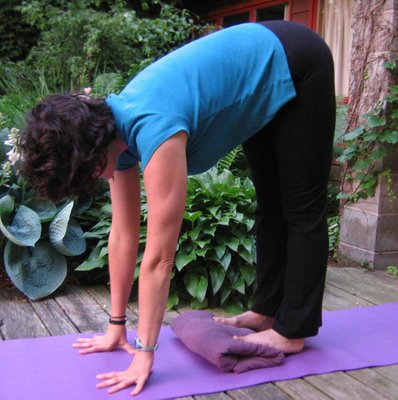
Right now my lesson plans are influenced by Coulter’s explanation of muscle reflexes and how they affect a muscle’s response to stretching. More specifically, I’m thinking about his discussion of the Myotatic Stretch Reflex. This is the reflex that is exhibited when you tap your kneecap or land on your feet after jumping; your muscles automatically contract after a sudden move to maintain your balance and absorb shock. It can also lead to tight, shortened muscles if the reflex is enacted a lot and not counter-acted with stretching (say, after a jog or hike). To prevent this automatic response of contracting, you have to ease into a stretch slowly so the muscles stay relaxed and are able to lengthen.
Experiment with easing into a stretch and notice how much length you can get by moving slowly (but don’t overdo it, always let the muscle open at its own pace). Here are slooow versions of Hastasana and Paschimottanasana for you to try. (Next month's issue will feature reader's contributions to Humor in Loose, Comfortable Uniform and Life in These Sanskrit States)
Slow stretches for Shoulders and Calves
1. Hastasana (Overhead Arm Stretch) In a comfortable, cross-legged seated position, interlock the fingers and stretch the arms in front of you, opening the space between the shoulder blades. Turn the palms away and slowly begin to raise the arms, until you feel your shoulders start to lift. Stop there and press your palms away, keeping the arms straight.
-Then, slightly bend the elbows and continue stretching the palms overhead and notice how the stretch moves into the shoulder joints.
-From here, begin to straighten the arms while keeping the shoulders away from the ears, stopping whenever you need to even if the arms aren’t straight. Notice how much deeper you are into the stretch than you would have been if you just kept lifting your straighten arms.
-Repeat with the fingers interlocked the “other way” (with the other index finger on top).

2. Paschimottanasana (Forward Bend) Roll your blanket—tightly if you have fairly flexible calves, looser if not. Now stand with the toes and balls of the feet on the blanket and the heels on your mat. Straighten and come to Tadasana (Mountain) making sure the tailbone points down to the floor and the shoulders are balanced over the hips. Breathe into this alignment and feel the calves start to open.
-With the hands in the hip crease (where the thighs meet the pelvis) begin to fold forwards from this joint, keeping the lower back long and the chest lifted. Reach down for the floor or your block when you are as far as you can fold. Try to sink your heels and balance your weight between the front and back of the foot. Breathe into the length of the spine and the continued opening of the calves.
-Now, slightly bend the knees and step off the blanket. Stay in the forward bend position, but notice how much further you can bend forward—or how much more comfortable the position becomes. Continue lengthening the calves and, if you want to deepen the pose, release the spine and let the head and shoulders hang down towards the floor. Cross the arms and tuck your hands into elbow crease so the weight of the upper body helps open the spine and increases your stretch.
-Slowly re-engage the spine and, with your hands on your thighs, come back to standing.
©Brenda K. Plakans. All Rights Reserved.

2 comments:
I like this physiologial info a lot. It makes sense. I have a question not related to this entry, but...
A month ago I say a bit on the "Today" show about a book on 'yoga in bed' which gives ideas for doing some yoga positions in places where ample floor space is not available (i.e. hotel rooms when traveling). Do you have thoughts on this or suggestions?
Erika
Erika,
I figure anytime/anywhere you feel like doing a little yoga, you should go for it. I wonder about the support of a bed, though. While it may be okay for relaxation poses, it is easier to keep the spine aligned when you are on a firmer surface. Standing poses would be awfully wobbly on a mattress, too. There are a lot of poses you can do in a narrow space (Triangle/Warrior2/Lateral Angle/Forward Bends)...maybe make a list for yourself, so you can pull it out on your travels!
Post a Comment